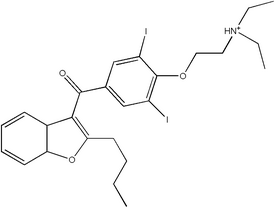METHOD OF PREPARATION
1. Calculate the required quantity of each ingredient for the total amount to be prepared.
2. Accurately weigh and/or measure each ingredient.
3. Pulverize the amiodarone hydrochloridc tablets to obtain a fine powder.
4. Add the glycerin to the powder and mix to form a smooth paste.
5. Add the Ora-Plus in portions and mix well.
6. Add sufficient Ora-Sweet or Ora-Sweet SF to volume and mix well.
7. Package and label.
PACKAGING
Package in tight, light-resistant containers.1
LABELING
Keep out of reach of children. Use only as directed. Shake well.
STABILITY
A beyond-use date of up to 40 days at room temperature and 90 days at refrigerated temperature can be used for this preparation.2
USE
Amiodarone hydrochloride is indicated in the treatment of ventricular arrhythmias.3
QUALITY CONTROL
Quality-control assessment can include weight/volume, pH, specific gravity, active drug assay, color, rheological properties/pourability, physical observation and physical stability (discoloration, foreign materials, gas formation, mold growth).4
DISCUSSION
Amiodarone (C^sub 25^H^sub 29^I^sub 2^NO^sub 3^.HCl, MW 681.8, Pacerone) occurs as a white or almost-white, fine crystalline powder that is very slightly soluble in water (about 0.72 mg/mL) and sparingly soluble in alcohol (12.8 mg/mL). It has a pKa of about 6.6 and should be protected from light. The pH of the injection is about 4.08. Commercial Pacerone 200-mg tablets also contain lactose monohydrate, magnesium stearate, povidone, pregalatinized cornstarch, sodium starch glycolate, stearic acid, KD&C Red 40 and FD&C Yellow 6. The 400-mg tablets also contain colloidal silicon dioxide, cornstarch, lactose monohydratc, magnesium stearate, povidone and D&C Yellow 10 Aluminum Lake.3,5
Glycerin (C^sub 3^H^sub 8^O^sub 3^, MW 92.10, glyccrol, 1,2,3-propane trio!) occurs as a clear, colorless, odorless, viscous, hygroscopic liquid with a sweet taste about 2/3 as sweet as that of sucrose. It has a specific gravity of about 1.25. It is miscible with water, methanol and 95% ethanol; practically insoluble in oils and chloroform; and slightly soluble in acetone. It is hygroscopic and should be stored in airtight containers in a cool place.6
Ora-Plus is an oral suspending vehicle that accepts dilution of up to 50% or more with water, flavoring agents or syrups and still retains its suspending properties. It has a pH of approximately 4.2 and an osmolality of about 230 mOsm/Kg. It is a thixotropic vehicle with a viscosity of approximately 1000 cps at 25°C. It contains purified water, microcrystalline cellulose, sodium carboxymethylcellulose, xanthan gum, carrageenan, sodium phosphate and citric acid as buffering agents; simethicone as an antifoaming agent; and potassium sorbate and methylparaben as preservatives.7
Ora-Sweet syrup is a flavoring vehicle for oral extemporaneous preparations. It is flavored with a citrus-berry blend and contains glycerin and sorbitol to prevent "cap-lock," a problem associated with many syrups. It is buffered to a pH of approximately 4.2 and has an osmolality of about 3240 mOsm/Kg. It contains purified water, sucrose, glycerin, sorbitol (5%), flavoring, sodium phosphate and citric acid as buffering agents; and potassium sorbate and methylparaben as preservatives.7
Ora-Sweet SF is a flavoring vehicle for oral extemporaneous preparations. It is a sugar-free, alcohol-free syrup flavored with a citrus-berry blend. It is buffered to a pH of approximately 4.2 and may be used alone or in combination with other vehicles. It will tolerate a dilution to 50% with dissolved actives in water or suspending agents and still retain an acceptable taste. It has an osmolality of 2150 mOsm/Kg. It contains water, sodium saccharin, xanthan gum, glycerin, sorbitol, citric acid and sodium citrate as buffers; methylparaben, propylparaben and potassium sorbate as preservatives; and flavoring agents.7
REFERENCES
1. US Pharmacopeial Convention, Inc. United States Pharmacopeia 27National Formulary 22. Rockville, MD: US Pharmacopeial Convention, Inc; 2004: 2345-2349.
2. Nahata MC. Stability of amiodarone in an oral suspension stored under refrigeration and at room temperature. Ann Pharmacother 1997; 31: 851-852.
3. [No author listed.] Physicians' Desk Reference. 58th ed. Montvale, NJ: Thomson PDR; 2004: 3245-3249.
4. Allen Jr LV. Standard operating procedure for performing physical quality assessment of oral and topical liquids. IJPC 1999; 3: 146-147.
5. Sweetman SC, ed. MARTINDALE: The Complete Drug Reference. 33rd ed. London: Pharmaceutical Press; 2002: 836-838.
6. Price JC. Glycerin. In: Kibbe AH, ed. Handbook of Pharmaceutical Excipients. 3rd ed. Washington, DC: American Pharmaceutical Association; 2000: 220-222.
7. Ora-Plus, Ora-Sweet, Ora-Sweet SF [product information]. Minneapolis, MN: Paddock Laboratories, Inc.
Copyright International Journal of Pharmaceutical Compounding May/Jun 2004
Provided by ProQuest Information and Learning Company. All rights Reserved



